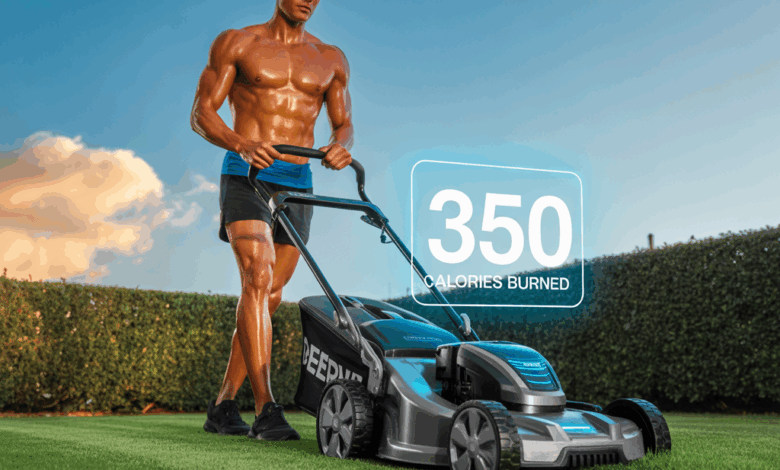How Many Calories Do You Burn Mowing The Grass

Ever finished mowing and thought, “Did I just earn my dinner?” Whether you’re pushing a neighbor’s vintage mower or riding a zero-turn across an acre, it’s natural to wonder how much energy that yard work really burns. In this article we’ll answer the question of how many calories do you burn mowing the grass, break down real-world examples, and show how to make lawn care part of a productive, calorie-burning routine.
How many calories do you burn mowing the grass? (Estimates and examples)
Calories burned while mowing depend on the type of mower, the intensity, your body weight, and how long you work. A reliable way to estimate is the MET (Metabolic Equivalent of Task) method:
- Calories burned ≈ MET value × body weight (kg) × time (hours)
Typical MET ranges for common mowing activities:
- Pushing a power mower / mowing the lawn (moderate effort): ~4.5–6.0 METs
- Pushing a heavy mower on hilly ground (vigorous): ~6.0–7.0 METs
- Riding lawn mower (light activity): ~2.0–2.5 METs
- Using a weed whacker, raking, or carrying bags (additional effort): adds calories depending on intensity
Examples (approximate):
- 150 lb person (68 kg) pushing a power mower at 5.5 METs for 1 hour: 5.5 × 68 × 1 ≈ 374 kcal
- 200 lb person (91 kg) pushing at 5.5 METs for 60 minutes: 5.5 × 91 × 1 ≈ 500 kcal
- 150 lb person riding a mower at 2.5 METs for 1 hour: 2.5 × 68 × 1 ≈ 170 kcal
So, depending on your weight and effort, mowing the lawn typically burns between 200 and 500 calories per hour if you’re pushing a mower — much lower if you’re riding. These are estimates; heart rate monitors and fitness trackers will provide personalized data with varying accuracy.
Why mowing can be a legitimate workout
Mowing engages multiple muscle groups: legs (walking, pushing), core (stabilizing), shoulders and arms (steering and pushing), plus occasional bending and lifting when bagging clippings. That makes it a functional activity that improves endurance and strength in real-world movement patterns.
Cardio and strength benefits
- Steady-state cardio: continuous walking and pushing increase heart rate for sustained calorie burn.
- Muscular endurance: repetitive pushing builds lower-body stamina.
- Core engagement: turning, reaching, and changing direction activates abdominals and lower back.
Practical tips to burn more calories while mowing the grass
If your goal is fitness, a few simple adjustments can turn yard work into a more effective workout:
- Use a push mower when possible. It forces constant effort vs. a riding mower.
- Keep a brisk pace — walk briskly between passes rather than dawdle.
- Do a 5–10 minute warm-up before starting (dynamic stretches, leg swings, light walk).
- Alternate sides and grip to prevent asymmetry and work both shoulders.
- Add bodyweight moves during short breaks: 10 squats or walking lunges to boost intensity.
- Carry the grass bag manually instead of emptying it at the mower to add resistance.
- Stay hydrated and wear sun protection — safety equals sustainability.
Make it interval-style
Turn mowing into a practical HIIT session: 10 minutes of steady mowing, followed by 1–2 minutes of faster-paced pushing or 20 bodyweight squats by the yard edge. Repeat. This increases cardiovascular load and calorie burn without extra time commitment.
Workout variations and yard-work routines
Here are three yard-focused sessions you can rotate through your mowing days:
- Endurance mow: Push the mower continuously at steady pace for the whole job. Aim for consistent heart rate. Great for aerobic base.
- Power mow: Short bursts of faster pushing and brisk walking between passes. Add loaded carries — carry the bag or a filled watering can for 30–60 seconds.
- Strength + core circuit: Every 10–15 minutes, stop for 1 set of 12–15 squats, 10 push-ups, and a 30-second plank. Resume mowing.
These approaches turn household chores into efficient, functional training that complements structured gym workouts. For more structured options, check out our workout routines page.
Healthy lifestyle advice to maximize results
Mowing alone won’t replace a balanced fitness program, but combined with solid nutrition and recovery it contributes to a healthier lifestyle:
- Pair active yard work with a nutrient-dense diet — track calories with our nutrition guides if you’re managing weight.
- Prioritize sleep and stress management; recovery is where gains happen.
- Use mowing days as an opportunity to get sunlight and vitamin D, but wear sunscreen and protective clothing.
Real-world examples: What homeowners actually burn
Case A — Small suburban lawn, 30 minutes, push mower: A 160 lb (73 kg) homeowner pushes for 30 minutes at moderate effort (~5 METs): 5 × 73 × 0.5 ≈ 182 kcal. Quick, effective, and can be combined with additional yard chores.
Case B — Large yard with hills, 90 minutes, heavy pushing and bagging: A 190 lb (86 kg) homeowner working at ~6.5 METs for 1.5 hours: 6.5 × 86 × 1.5 ≈ 838 kcal. Long, demanding, and close to a full workout.
These examples show how time, intensity, and terrain dramatically affect calorie burn.
Safety and smart practices
- Wear closed-toe shoes with good traction, eye protection, and gloves.
- Avoid lifting heavy bags with your back — use legs and keep load close to body.
- Take breaks in hot weather and monitor for dizziness or excessive fatigue.
- Listen to your body: yard work can aggravate pre-existing issues like lower-back pain — consult a professional if unsure.
Frequently Asked Questions
It varies by effort. Pushing a mower typically burns ~300–500 calories per hour for most adults; riding a mower burns much less (~120–200 kcal/hr). Use your weight and MET values for a tailored estimate.
Mowing can be a good cardio and functional strength activity, especially if you use a push mower and add intervals or strength moves. However, for balanced fitness you’ll still want a mix of targeted strength training, flexibility, and higher-intensity cardio sessions available in structured workout routines.
Riding a mower counts as light activity (low calorie burn) because you’re mostly seated. You can increase overall activity by tasks like raking, trimming, carrying bags, or walking to collect tools, but for substantial calorie burn, push mowing is better.
Conclusion — Takeaway and next steps
So, how many calories do you burn mowing the grass? In short: a lot more than you might think if you’re pushing and working at a steady pace. Estimates typically range from roughly 200–500 kcal per hour for push mowing, and much less for riding mowers. Use intensity tweaks, simple strength moves, and smart safety practices to make yard work a productive part of your fitness plan.
Ready to make your lawn day count? Try one of the yard-work workout variations above, track your session with a heart-rate monitor, and pair it with tips from our nutrition guides and wellness tips to maximize results. Share your mowing workout in the comments or sign up for our newsletter to get seasonal fitness tips delivered to your inbox.





